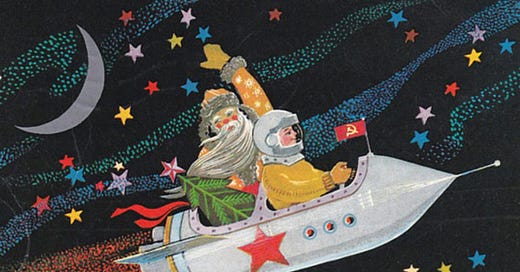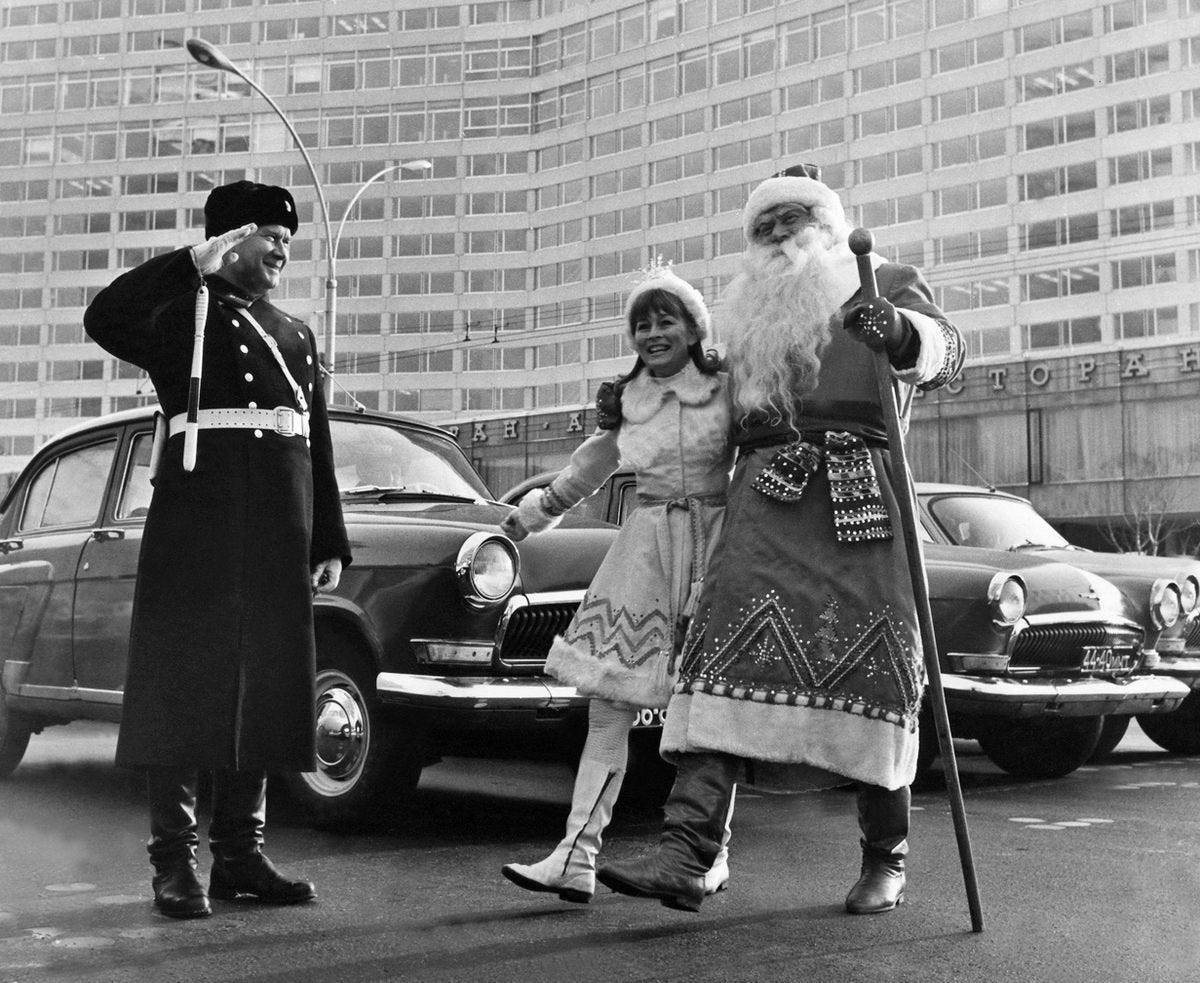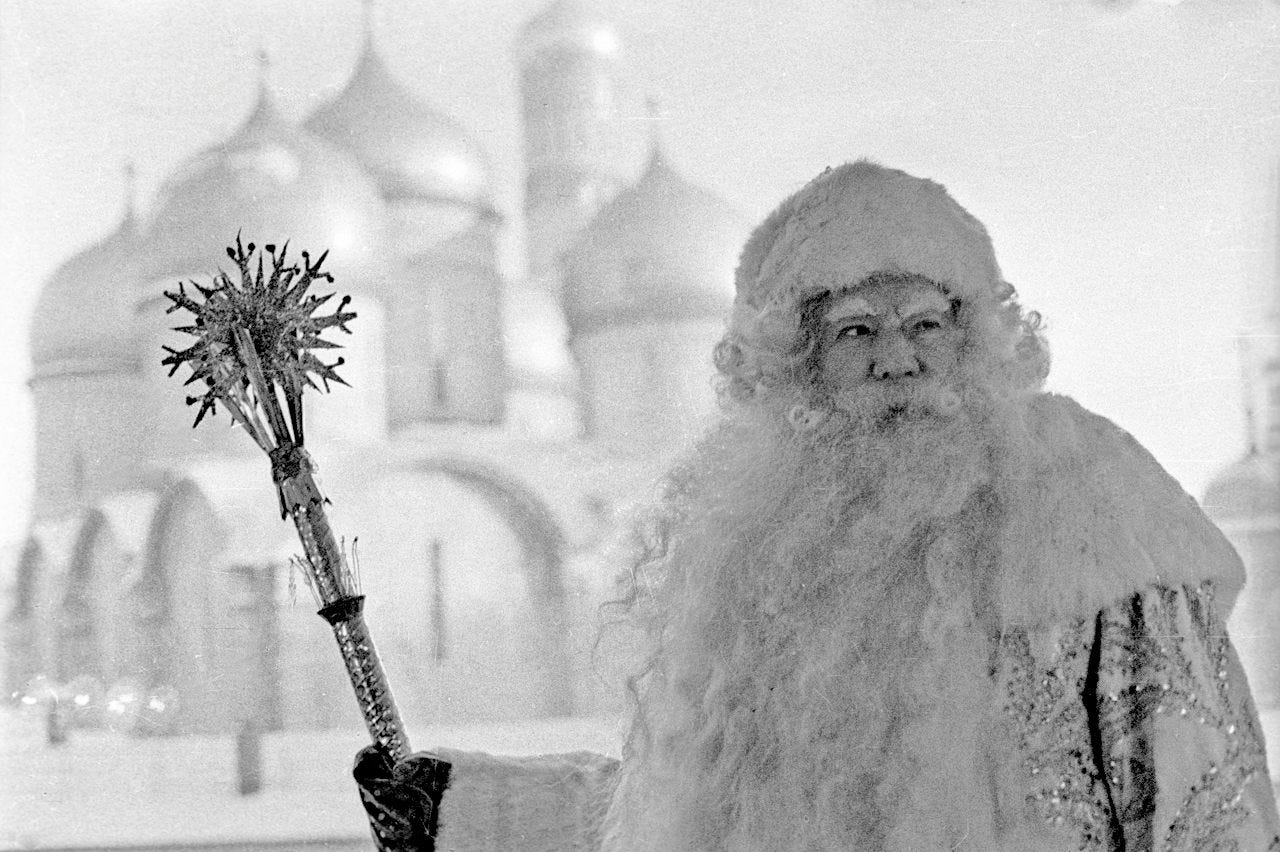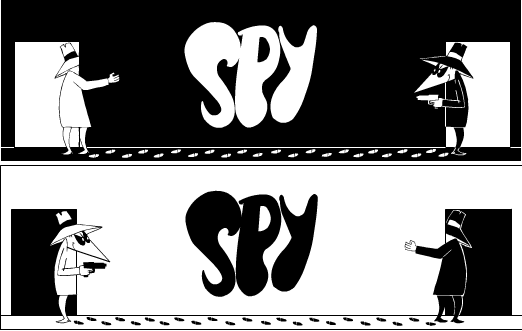How Santa Claus Survived The Soviet Union! The Story Of Ded Moroz
Santa Claus exists under different names and traditions all over the world, but the oddest story has to be Soviet Santa!
Santa Claus vs. Grandfather Frost (Дед Мороз):
As we end 2024 I’ve been posting great stories from our past year and articles and links to articles not posted here before. Atlas Obscura did this article on Soviet Santa and its pretty amazing. I love their website and go to it every week - you should, too. Here’s some excerpts from the article:
There are versions of the character widely known as Santa Claus throughout northern, central, and eastern Europe—all large, bearded men who arrive with winter to bring gifts to children. Russia is not exempt from this, but the Russian version, Ded Moroz, which translates roughly as “Grandfather Frost,” has a particularly strange, convoluted history.
Ded Moroz today is about what you would expect. He has a long white beard, wears a fur-lined hat, has an animal-towed sleigh, and delivers presents to well-behaved children when it is cold outside. But Ded Moroz’s last hundred years have been violent, political, and full of massive social upheaval. This, for Santa, you would not expect. As a result, his status is unlike that of any of his holiday peers around the world. For one thing, he isn’t even necessarily associated with Christmas.
Christmas was a major holiday under the tsars, though not as important as Easter. It wasn’t really a festival exactly, but more of a somber religious holiday marked by fasting and long church services in Old Church Slavonic (which, by the 19th century, hardly anyone could understand). The Russian Empire of the 18th and 19th centuries was religiously diverse, but in most of what is now Russia and Belarus, if you were Christian, you were probably Eastern Orthodox. The Eastern Orthodox Church used, and sometimes still uses, a totally different calendar than the rest of the Russian Empire—the Julian one, which is 13 days behind the more common Gregorian calendar. This means that in Orthodox communities, Christmas Eve and Christmas Day celebrations would actually take place on January 6 and 7, out of step with the rest of the Christian world.
Ded Moroz emerged around the late 19th century. One of the first major cultural introductions of the character was in the 1873 play The Snow Maiden, by Alexander Ostrovsky, one of the most important playwrights in Russian history. Ostrovsky was often a political writer, and The Snow Maiden is an odd entry in his oeuvre. It’s a fairytale, based in part on obscure and largely forgotten pre-Christian pagan mythology, and designed to promote a different kind of Russian patriotism than the Imperial government’s brand. The play was published—not necessarily a given for Ostrovsky, who had many of his plays censored or banned—and eventually rewritten as an opera, which was performed many times.
The play included the notable characters of Snegurochka (the titular maiden) and her grandfather, Ded Moroz. He was based on a very old and mostly forgotten character in Russian mythology, an elemental snow demon. Demons of his breed aren’t necessarily bad guys. Ded Moroz was actually a good omen, because he was associated with particularly brutal winters, which, in Russian superstition, mean a good harvest the following year. By the time of Ostrovsky’s play, Ded Moroz and the other pagan demons were thousands of years old and had not had a place in the contemporary Russian Empire.
The educated classes loved The Snow Maiden, and interest in its characters, especially Snegurochka (who was created by Ostrovsky) and Ded Moroz, grew.
Suddenly there was a ready-made, deeply Russian version of Santa Claus, and the less-religious Christians began to use him in Christmas celebrations in essentially the same way that Santa Claus and his kin were used elsewhere.
He rewards good children with presents, and brings celebration and good tidings. He wears a big, fur-lined coat, though Ded Moroz’s is often an icy blue or patterned white, along with traditional felt valenki boots. He also carries a magical staff, though it’s not clear what he does with it. His flying sleigh is technically a troika, pulled by three horses, with no reindeer in sight. Ded Moroz is usually accompanied by Snegurochka, his granddaughter, and she is always dressed in white or very pale blue. She is sort of Ded Moroz’s helper, more of a partner than the elf-employees of Santa. He doesn’t live at the North Pole; a few northern sites lay claim to being is hometown.
Among the stated goals of the Communist Revolution of 1917 was to abolish organized religion and establish atheism throughout the Soviet Union. “It was remarkably effective,” says Catherine Wanner, a historian and anthropologist at Penn State who works on religion in the Soviet Union. “I’m not certain they produced atheists, but they certainly got rid of overt religious celebrations.” Attacks against organized Christianity came in several brutal waves throughout Soviet history. Priests were thrown in camps or simply executed, churches were destroyed, and the ruling powers bombarded the country with pro-science—or, more accurately, anti-religious—propaganda. One example: There were patrols at one time that actually looked in windows for Christmas trees. If they saw one, that family was in serious trouble.
The brutality and singular focus of the attack on organized religion produced a culture, especially in the cities and larger towns, of complete terror at the idea of practicing religion. But, starting with a 1935 letter from a prominent Soviet politician, the idea of some kind of wintertime holiday began to take hold. By 1950, it had been firmly established. It was not Christmas, of course. The wintertime Soviet holiday would be “Novy God,” or “New Year.”
These holidays are treated separately in most places today, but in the Soviet Union, most of what had previously been associated with Christmas grew to become associated with Novy God. For the last four or five decades of the Soviet Union, everyone had a Novy God tree, and Ded Moroz made an appearance. It was not—for a while, at least—as consumerist as Christmas. It was more like Thanksgiving: national, secular, marked by feasting and family.
The Young Communist League held an anti-religion demonstration in Moscow in 1923 (left). Propaganda, such as this 1928 Anti–Ded Moroz cartoon from Ukraine, reflected the Soviet distrust of religion (right). The caption roughly translates to “Go away from our style of celebration.”
In this context, Ded Moroz’s pre-Christian roots were an asset. The Soviet leadership never said this explicitly, but it seems likely that they permitted and even encouraged Ded Moroz because he was, theoretically, Russian, born and bred. Depictions of Ded Moroz changed with the times during the Soviet era. For the Space Race, he was sometimes shown driving a spaceship rather than a troika. At other times he was depicted as a muscular, hard-working, semi-shirtless emblem of Communist industry.
After the Soviet Union collapsed in 1991, religious practice became legal again. But that put those who were theoretically Christian in a very weird position with regard to Christmas. They were able to celebrate Christmas, but they had never done it before. In fact, their parents, grandparents, and even great-grandparents had likely never celebrated Christmas. And Christianity in Russia still largely means the Eastern Orthodox Church, which carries its own complicated baggage.
Today, Russia has what’s called a “holiday marathon.” It starts with the Gregorian calendar Christmas on December 25, passes through Novy God, which remains a much bigger holiday, and finishes with Christmas as it appears on the Julian calendar, on January 7. It’s sort of exhausting, but Novy God still stands out as the most important single date. Gift-giving largely happens then, and when you wish someone the tidings of the season, you say “С Новым Годом,” or “Happy New Year.”
Read the full article at ATLAS OBSCURA
Behind the paywall: Mission Behind the Iron Curtain - The Spying Game, Pt. 2
Plus Part 1 if you missed it
Western intelligence services shift their focus to East Germany as the Warsaw Pact’s major deployment zone. Nowhere else did western services get as close to Soviet military equipment. At the same time, the KGB was sending their spies to infiltrate NATO forces in the West.
Keep reading with a 7-day free trial
Subscribe to Hidden Cold War History to keep reading this post and get 7 days of free access to the full post archives.







